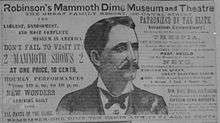Dime museum

Dime museums were institutions that were popular at the end of the 19th century in the United States. Designed as centers for entertainment and moral education for the working class (lowbrow), the museums were distinctly different from upper-middle class' cultural events (highbrow). In urban centers like New York City, where many immigrants settled, dime museums were popular and cheap entertainment. The social trend reached its peak during the Progressive Era (c. 1890–1920). Although lowbrow entertainment they became birthing grounds for the careers of many notable Vaudeville-era entertainers including Harry Houdini, Lew Fields, Joe Weber & Maggie Cline.
Baltimore
In Baltimore, Maryland, Peale's Museum is credited as one of the first serious museums in the country. This type of attraction was continued in the work of the American Dime Museum operated for eight years before closing permanently and auctioning off its exhibits in late February 2007.[1]
Boston
Kimball's Museum and Austin & Stones Museum in Scollay Square were both well known attractions, the former having a friendly connection to, and sometimes competition with, P. T. Barnum. Barnum and Moses Kimball even shared "Fee Gee Mermaids" on a regular basis.
Cincinnati
Both John James Audubon and sculptor Hiram Powers produced displays for the Western Museum, organized by Dr Daniel Drake in 1818 and continued by Joseph Dorfeuille. "Satan and his Court" wax figures with moving parts and glowing eyes are typical of these displays.
New Orleans

On Canal Street, "Eugene Robinson's Museum and Theater" featured entertainments on the hour and also presented some of its attractions on a nearby riverboat. The common promotion gimmick of a brass band at the front entrance of these Dime Museums featured some of the earliest documented traditional jazz; Robinson's riverboat museum also hired Papa Jack Laine.
New York City
P.T. Barnum purchased Scudder's Dime Museum in 1841, and transformed it into one of the most popular single cultural sites that has ever existed. It was called the "American Museum". P.T. Barnum and Charles Willson Peale and his sons introduced the so-called "Edutainement" which was a moralistic education realized through sensational freakshows, theater and circus performances, and many other means of entertainment. The first incarnation "American Museum" on Anne Street, burned down in 1865. It was relocated further up Broadway, but this venue too, fell victim to fire.
For many years in the basement of the Playland Arcade in Times Square in New York City, Hubert's Museum featured acts such as sword swallower Lady Estelene, Congo The Jungle Creep, a flea circus, a half-man half-woman, and magicians such as Earl "Presto" Johnson. This museum was documented in photography by Diane Arbus. Later, in Times Square, mouse pitchman Tommy Laird opened a dime museum that featured Tisha Booty - "the Human Pin Cushion" - and several magicians including Lou Lancaster, Criss Capehart, Dorothy Dietrich, Magician Dick Brooks, and others.
References
- ↑ "American Dime Museum, reportage from the Baltimore museum on its last day of existence". Site Bits. 2007. Retrieved 3 January 2014. External link in
|work=(help)
